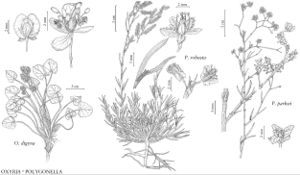Oxyria digyna
Hort. Kew., 158. 1768.
Plants (3–) 5–50 cm. Stems 1–4 (–8), often reddish, simple or branched distally. Leaves rarely 1–2 on stems, somewhat fleshy; ocrea hyaline or brownish hyaline, 2.5–10 mm, glabrous; petiole 1–15 cm; blade palmately veined with (5–) 7 (–9) basal veins, 0.5–6.5 × 0.5–6 cm, base cordate, apex rounded. Inflorescences (1–) 2–20 cm; peduncle 1–17 cm. Pedicels spreading or reflexed, jointed proximal to middle, (1–) 3–5 mm. Flowers 2–6 per ocreate fascicle; perianth 1–2.5 mm; outer 2 tepals spreading in fruit, navicular, 1.2–1.7 × 0.5–1 mm, inner 2 tepals appressed in fruit, broadly elliptic to orbiculate or obovate, 1.4–2.5 × 0.7–1.6 mm; stamens 1.5–2 mm; anthers 0.3–0.8 (–1.1) mm; stigmas conspicuously exserted at anthesis, red. Achenes 3–4.5 × 2.5–5 mm including 2 wings, apex notched; wings reddish or pinkish, veiny. 2n = 14.
Phenology: Flowering Jun–Sep, fruiting Jul–Oct.
Habitat: Early melting snowbeds and zones of snow accumulation, gravel bars, mudflats, tundra, scree slopes, crevices in rock outcrops, talus slopes
Elevation: 0-4200 m
Distribution

Greenland, Alta., B.C., Nfld. and Labr., N.W.T., N.S., Nunavut, Que., Yukon, Alaska, Ariz., Calif., Colo., Idaho, Mont., Nev., N.H., N.Mex., Oreg., S.Dak., Utah, Wash., Wyo., Europe, Asia
Discussion
Morphological and physiological differences between arctic and alpine populations of Oxyria in North America have been documented (H. A. Mooney and W. D. Billings 1961). Arctic plants (Alaska, northern Canada, and Greenland) taken from the field and grown in controlled environments tend to bear inflorescences with more branches, leaves with blades that are wider, and flowers with a more stable number of stamens as compared to alpine plants from populations in the south (California, Colorado, Montana, and Wyoming). Northern plants also have a greater tendency to reproduce asexually, often producing rhizomes and exhibiting relatively lower seed production.
Inuits consume the raw or cooked leaves and stems as a green or mixed with seal blubber or seal oil. Native American tribes in the Rocky Mountains also are reported to use the leaves as a salad (D. E. Moerman 1998). Caribou, muskoxen, and geese are reported to eat the leaves and stems, and arctic hares and lemmings consume the fleshy rhizomes (A. E. Porsild 1957).
Selected References
None.
Lower Taxa
"/2" is not declared as a valid unit of measurement for this property.
